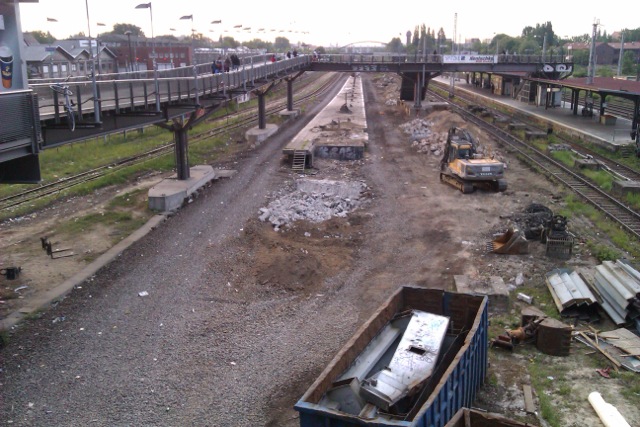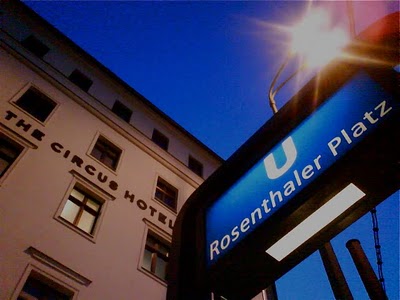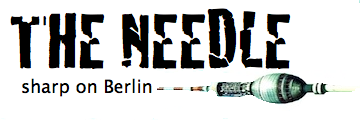36 Hours in Berlin (and not a minute more)

Did you ever wonder at the intentions of tourists who come to Berlin as voyeurs to the horrors of the 20th century? After a weekend chock-full of terror, mass murder, surveillance, and the legacy of defeat, it’s a wonder they would ever want to pay a return visit to the German capital. Indeed––now that we’re thinking about it––how would you devise an itinerary to Berlin that ensures there’s no possibility of a return visit?
The Needle tips its hat, with this post, to the New York Times’ travel section, with a parody of its column, 36 hours in XXXX (fill in a city name), and an itinerary that will have your weekenders breathing with relief the moment their plane takes off home. Might we note, to the less-easily humoured out there, that the public memorializing of past crimes is one of Germany’s greatest achievements: what we object to here is the collectionist attitude of atrocity tourism, where the attempt to empathize with victimhood and collect it digitally trumps lucid and humbled historical inquiry.
36 Hours in Berlin (and not a minute more):
9 am Try to visit Berlin in the off-season, in November or January, when it’s not packed with tourists and the darkness and brisk weather bestow upon the capital a hauntingly serious gravitas. A well-connected offbeat location for your hotel is the area along Kaiserdamm, with adjacent autobahn connections on the Ring road and S-Bahn service into the centre. There are plenty of local services: one of Berlin’s largest BMW dealerships, Cancún (a German-Mexican fusion franchise) and the breezy exhibition grounds of Messe-Nord (should you be in town for the international fruit and vegetable trade show or the erotic lifestyle products fair).
11 am From Kaiserdamm, it’s a lazy journey by U-Bahn into the pulsing centre of West Berlin, around Zoo Station and Kurfürstendamm, where you will discover elegant high-street shopping, and more comfortingly familiar quantities such as H&M and Zara. Explore German retailing at Peek & Cloppenburg and Karstadt. The 80s sex shops around Zoo Station are a naughty introduction to German fetish.
1pm The circuitous U2 line brings you to Potsdamer Platz: Berlin’s more Easterly node of commercial bustle, the centre and symbol of the regenerated Berlin, build on high expectations by high-profile architects such as Renzo Piano. Here you will find headquarters of Mercedes and Deutsche Bahn, a sprawling underground network of pedestrian shopping––a good place to escape the winter sleet. Absorb the mid-winter gruffness of the mall staff, and appreciate their brutal honesty as a cherished part of local character. Make sure you admire the rigidly hexagonal geometry of Leipziger Platz, site of a new shopping centre on the location of Wertheim, the elegant Jewish-owned department store whose owners were dispossessed of their property under the Nazis. Lunch at the German-Italian fusion franchise Vapiano, located near the Wall’s former death strip, and a coffee at the historically-themed Café Josty––the erstwhile intellectual parcour of vibrant Weimar Berlin, now housed within the corporate headquarters of Sony Europe––round out the visit to the city’s historic crossroads.
2pm Potsdamer Platz is conveniently located near the centres of Nazi Terror. Begin your exploration of Germany’s darkest moments at the Topography of Terror, on the site of the former Gestapo headquarters. Located on a former Arts School, the basement studios where political opponents were tortured are visible under the remnants of the Berlin Wall. Contemplate the long interconnected history of totalitarianism of diverse ideological origin. Not far is the location of Hitler’s Bunker, now located in the car park of a brown modular East-German housing estate. Next to this is the federal Memorial of the Murdered Jews, a sprawling city block that recalls a graveyard. The passages between the stones prompt tourists spontaneously to play hide and seek and to take pictures of one another standing and smiling on the grave-like structures, jumping intrepidly from one to the other. These activities, however, are officially discouraged. The famous Brandenburg Gate is the centre point to this area of memorial tourism, and vendors dressed as East German border guards will happily stand with you to take your picture and vandalize your travel documents. Down Unter den Linden you will find the city’s best souvenir shops, beautifully lit (the sun has already gone down at 3pm).
7pm 1 Euro Shots on Oranienburger Straße is an obligatory stop to unwind after the day’s atrocity tourism. The site of the former squat, Tacheles––a hidden, insider tip, and the centre of the Berlin erstwhile underground scene––is now being renovated by investors. The street is also known for German-Indian-Asian fusion mega restaurants, and as Berlin’s prostitution mile, where you can admire the resilience of women dressed only in plastic mini-skirts and matching lace-up boots in the sub-zero January evenings.

10pm Rosenthaler Platz is Berlin’s youth capital, a short walk through Berlin’s former Jewish ghetto (you may pass by the Jewish cemetery on Große Hamburger Straße, razed by the Gestapo). Here, every corner is occupied by youth hostels. Not far is the Easyjet hotel, a cheap and cheerful Ibis, and other international ventures, along with fast-food joints that cater to urban tourists with Taliban-hipster beards, feeding on that elusive category of ‘cool’. Rosenthaler Platz is also the new centre of Berlin’s emerging Currywurst scene. A Berlin specialty, Currywurst is a concoction developed out immediate post-war rationing: sausage with the skin on, buried in ketchup and curry powder, with frozen fries still provocatively al dente. When you are feeling full, then cut the grease with more shots, or a pub crawl organized by one of the local hostels. Not far from Rosenthlaer Platz is one of Berlin’s most famous English-speaking backpacker pick-up scenes, the bar at Wombat’s hostel. Plenty of Berlin backpackers don’t get beyond the establishment’s front door––packing sleep, drink, and other forms of entertainment under a single roof.
2am If there is one legendary club that will entice you farther East, it has go to be Berghain—the world’s megaclub, known for its long lines, excruciating waits, and mysterious and brutalizing door policy. No visit to Berlin is complete without a three-hour skulk before the temple to electronica, a former Communist-era power plant, in the early morning cold, in a line that doesn’t move except when there’s the collective expulsion of a line-jumper, or a spasm of sharp-shouldered frustration. But simply being in line (Schlangedasein) is arguably the archetypal Berlin experience. That seeming unreachable then exhilarating moment when you finally reach the front of the line––with your four heterosexual buddies, in your best designer polo shirts, open to the sub-freezing cold, lips frozen with Becks cooler, but nonetheless chirpy, smiling, and vocally Anglophone––will be the climax of your night out. It is the moment when you are graced with the attention of the pierced and tattooed bouncer, whose tilted head ejects you from the line and back to Ostbahnhof, crowded with homeless alcoholics . You have just had the quintessential Berlin experience, to tell all your friends about once you get home. Connect early morning, via Alexanderplatz, for the meandering U2 service through the centre back to your hotel.
9am But who needs sleep in the city of pleasure? A great way to get the morning juices flowing is the bracing experience (especially in winter) of a beer bike. You power your own multi-seated conveyance, and work off beer calories as you simultaneously drink, pedal and careen wildly between the city’s system of trams. It’s an adrenaline-spiked, ice-slicked, experience. Pass Checkpoint Charlie, an entrepreneurial museum space (comparable to the GDR museum) next to the reconstructed border installation manned by costumed guards (who again will issue false stamps and pictures for payment).
11am Have the beer bike drop you off at Friedrichstraße, for your S-Bahn north to the former Nazi work-camp of Sachsenhausen. An alternative day-trip is to the frozen waters of Wannsee, and the villa of the Conference that signed the Final Solution into action. You might think a trip to a Nazi camp is best experienced in mid-winter and hungover, and then correct yourself when you realize it’s quite impossible to ever truly empathize with the victims of Europe’s most significant tragedy. You wonder, for a brief moment, whether you should even be taking pictures, what the appropriate response might be to something so terrible.
4pm If you return early enough in the afternoon, you may want to visit the Berlin Dungeon, brought to you by the creators of Madame Tussauds (or alternatively another site worth visiting such as the Stasi Prison). Here, crimes of the past are gruesomely reproduced in a darkened subterranean haunted house. This may seem a terrible idea in a city like Berlin, but the museum carefully edits the crimes it gruesomely recreates for its visitors, and leaves out most of the ones visitors have already checked off by visiting Berlin’s Nazi and Cold War sites. Notice how even the sound of German around with you is closely associated to the Third Reich, due to your childhood diet of Hollywood films.
6pm There’s just a little time left for more Currywurst in Rosenthaler Platz, or back in the direction of your hotel, in the forlorn bus parking in front of Zoo Station. You can line your stomach, so it’s ready for those shots of recovery whiskey to be provided in tiny disposable bags on Ryanair and Easyjet.
9pm Load up on expensive duty free Jägermeister and drink secretly in the tiny toilets of the former East German airport terminal. This is preferable to waiting anxiously for hours in the long hallway with negligible seating, or at the stand-up counters of the Burger King. It dulls the pain too, as you pay your low-cost carrier excess baggage fees when your carry-on cannot be removed from the luggage sizer at the gate. As your flight takes off from Schoenefeld, explore the ingenuity of German efficiency and engineering as you peer down at the sprawling airport facility iced closed below you. Wonder why your flight did not board from here. As your blue and yellow bus breaks through the low-cloud cover and darkness hovering over the German capital, breathe a breath of relief. You feel broken and exhausted. You have experienced, in a very personal way, a little piece of Europe’s dark history. Haven’t you? At least your memory card is full enough to pre-empt the necessity of a return visit. Battered, disheveled, dispirited, and with dark circles under your eyes tomorrow morning in your office cubicle, your colleagues whisper enviously about your industrial weekend in the capital of cool. The word ‘Berlin’ evokes a feeling both dark and imprecise. Look at how it’s changed you, and you’ve been away just 36 hours.
